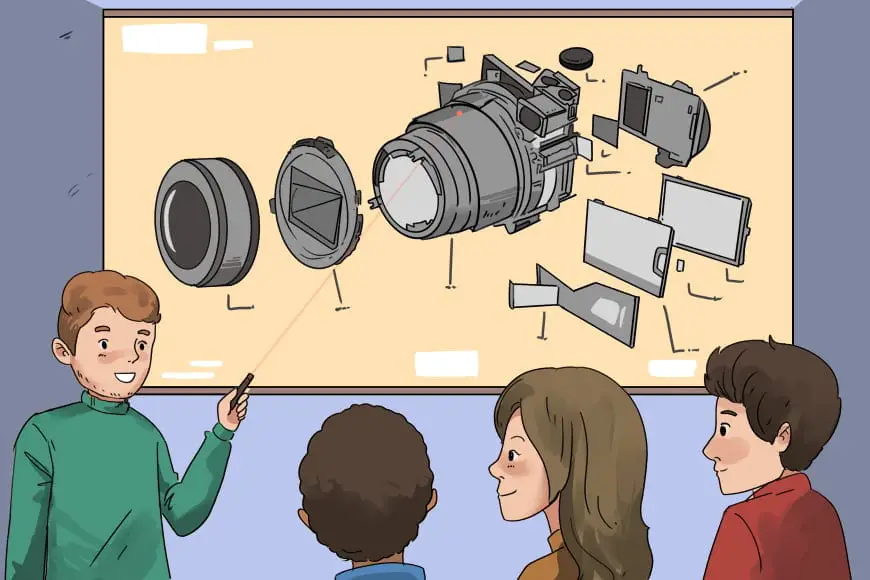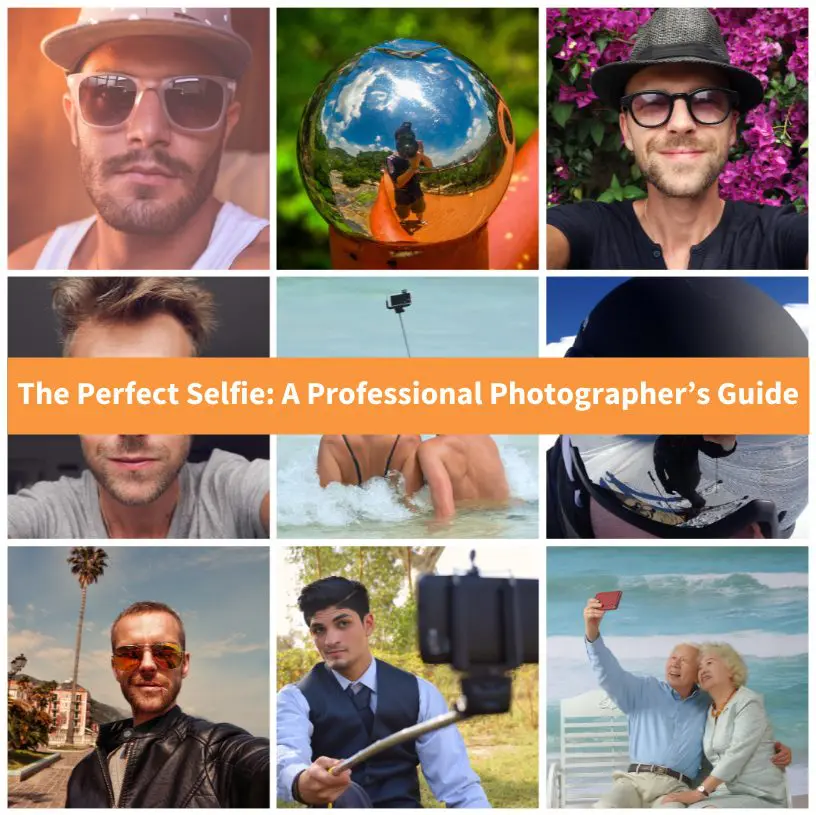
Do you know which camera parts are most important and what they are doing? That’s a subject that may sound irrelevant to many of us, but you’ll be surprised at how many photographers just use their cameras without knowing much about them. That’s exactly why I think it’s time for a little lesson about camera parts and their purpose in our photographic journey.

Camera Built Through the Years
At the very beginning, the cameras were simple and had a very straightforward purpose and usage. You would have a mirror for seeing the image, film, and a button to trigger the shutter. Decade after decade, new features were added to the world of cameras. The auto-settings, the flash, and the interchangeable lenses are all camera parts that led to this era of versatility and complexity.

Therefore, prepare yourself for a journey through our camera parts! In this article, we will talk about the visible and invisible components of your camera and the parts that are super useful to us but not so popular.
The Main Camera Part: The Camera Body
This is the camera part that you are going to enjoy the most. The look of the camera depends a lot on the materials used in the body. Firstly, plastic is very common. However, the premium camera builds will contain aluminum and even carbon fiber in some cases.
Also, mirrorless cameras often have more compact bodies than DSLR cameras. The last ones typically have larger builds. Why? DSLR models must make room for an internal mirror that reflects light from the lens into their optical viewfinder. This mirror is not required for mirrorless cameras.
Aside from this, the fundamental design and component operation of DSLR and mirrorless cameras are pretty similar.

Image Sensor and Processing Chip
First of all, let’s find out more about the purpose of this camera part. The sensor captures the light that comes through the lens and converts it into a digital format. So, many consider this one of the most important camera parts.
Every sensor is formed by pixels of different sizes. These pixels are converting the light into electrical signals that are being processed into the camera’s chip. That’s how you get a picture and how a camera can “see”. Next, the processor does a lot in these conditions, from adjusting the noise to balancing the colors.

Moreover, there are several sorts of sensors. Complete-frame sensors are frequently seen in higher-end digital cameras. They provide a digital size equal to a complete 35mm film frame in an analog camera. On the other hand, some cameras provide smaller, cropped sensors in formats like APS-C, which results in reduced viewing angles when seen from a specific distance.
The Shutter (An Essential Camera Part)
This little piece of plastic is the one that makes colored photos possible. Without the shutter, the light will hit continuously on your sensor, and everything will be white. So, this camera part takes care of how much light gets inside the camera based on its speed. Therefore, the faster the shutter, the less light you will capture.
Also, keep in mind that, without pressing the shutter button, the camera’s shutter stays closed.
Another essential feature to remember is the “Bulb” option on the camera. It allows you to leave the shutter open for several seconds, minutes, or even hours. Have you ever seen photographs of whirling nighttime stars or light trails left by passing cars? Well, that’s how they were photographed.
So, cameras can go from bulb “speed” up to 1/8000 of a second (where everything just freezes).

The ISO (Sensitivity to Light as a Numerical Value)
Although it’s not a physical camera part, a digital camera’s ISO is just as significant as shutter speed and sensor size in terms of how effectively it can capture pictures in low light. Here is a little catch: a good image sensor and a good lens allow you to have higher ISO values without noise.
Also, on some modern professional cameras today, you can reach 3000 “artificial light” and the image will look just fine. However, you won’t be able to accomplish that with an entry-level camera.

Camera Parts: The Autofocus System
A camera’s autofocus technology enables you to swiftly and easily snap pictures that automatically concentrate on particular moving or motionless subjects.
Many of the top cameras on the market now contain hundreds of phase detection and contrast detection autofocus points on their sensors. These points being processed can produce incredible, crisp photos of moving things in a matter of milliseconds.
Also, this feature is one of the stepping stones in sports photography, wildlife photography, and many others where human adjustments will cost time and the loss of incredible moments.

Camera Parts: Lens and Lens Aperture
The majority of professional and semi-pro cameras include interchangeable lenses that can be equipped with a variety of lens types as needed.
However, from entry-level lenses (Canon 50mm F/1.8) to made-in-Switzerland lenses (ZEISS Milvus 85mm f/1.4), the materials and accuracy will always depend on the quality.
Most camera manufacturers also provide a range of zoom, prime, wide-angle, and other lens options for their exclusive mounts for the various camera types. So, lenses do more than just transmit light to the camera’s sensor. Additionally, they include a movable diaphragm that regulates the quantity of light that comes in. This important procedure is known as aperture.
F-stops are units used to measure aperture. A smaller f-stop, such as f/1.4, results in a bigger aperture and a significantly deeper depth of field, which causes the backdrop to be fuzzy as the camera focuses on a particular close-up object.
On the other hand, a narrower aperture and a longer depth of field are both indicators of a higher f-stop, such as f/32. This one limits the amount of light entering the image.

Controls and Buttons (Interactive Camera Parts)
Control dials and buttons are the body’s exterior components for digital cameras. These are the camera parts that let us interact with the body.
The fundamental controls that the majority of digital mirrorless and DSLR cameras will feature a shutter release button, a power button, a dial for varying exposure compensation settings, and dials for regulating ISO and shutter speed. However, remember that these can vary from one camera to the next.
Next, let’s talk a little about the LCD screens. Nearly all contemporary cameras now have LCD screens. It performs three basic tasks: examining photos after you’ve taken them; and manipulating basic camera features through computerized menus. Lastly, if you’re not using the viewfinder, it arranges images before shooting.

What’s Your Favorite Camera Part?
Finally, you’ve found out all you need to know about your camera and its features. It’s essential to possess this information when purchasing a new camera for different photographic experiences. Therefore, as time passed, the complexity of cameras increased, as did their utility. Our job is to understand that and keep up with the changes in order to make the best purchase decisions.
Last but not least, if you want to choose your next camera after reading this article, go check out another one of mine: The Best Mirrorless Camera for Beginners in 2023.
Share:






